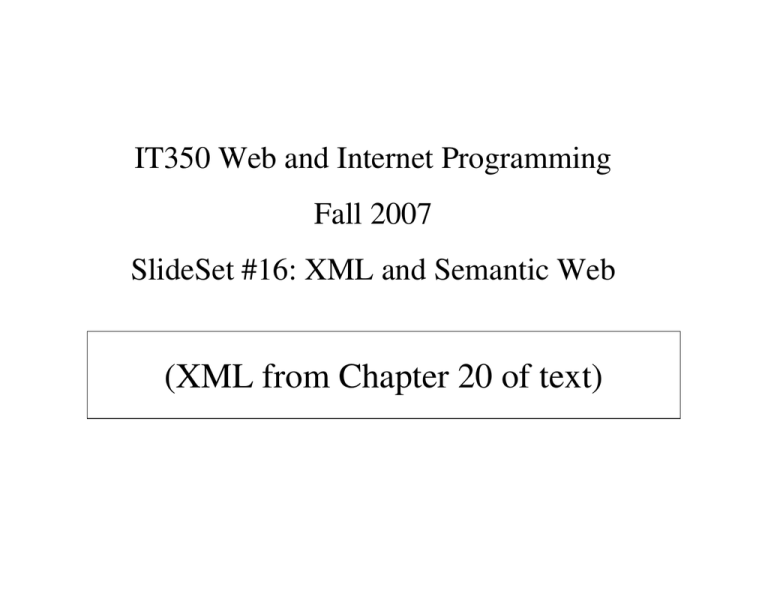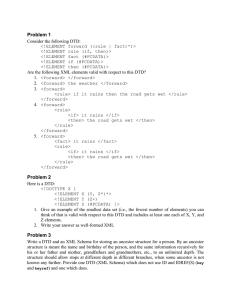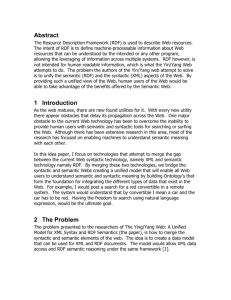(XML from Chapter 20 of text) IT350 Web and Internet Programming
advertisement

IT350 Web and Internet Programming Fall 2007 SlideSet #16: XML and Semantic Web (XML from Chapter 20 of text) Outline • Why Structured Data? • Types of Structured Data – XML and Friends – RDF and Semantic Web Structured Data • Overall Goal – add more “structure” to our otherwise freeform data • Why? • HTML/XHTML primarily designed to be rendered for ___________ viewing. We want something that can be exploited by ____________. XHTML XML 1 <?xml version = "1.0"?> "1.0"?> 2 3 <!-<!-- Fig. 20.1: article.xml --> --> 4 <!-<!-- Article structured with XML --> --> 5 6 <article> 7 8 <title>Simple <title>Simple XML</title> XML</title> 9 10 <date>July <date>July 15, 2003</date> 2003</date> 11 12 <author> 13 <firstName>Carpenter <firstName>Carpenter</firstName> Carpenter</firstName> 14 <lastName>Cal <lastName>Cal</lastName> Cal</lastName> 15 </author> 16 17 <summary>XML <summary>XML is pretty easy.</summary> easy.</summary> 18 19 <content>Once <content>Once you have mastered mastered XHTML, XML is easily 20 learned. You must remember that XML is not for 21 displaying information but for managing information. 22 </content> 23 24 </article> Another example 1 <?xml version = "1.0"?> "1.0"?> 2 3 <!-<!-- Fig. 20.3: letter.xml --> --> 4 <!-<!-- Business letter formatted with XML --> --> 5 6 <!DOCTYPE letter SYSTEM "letter.dtd"> "letter.dtd"> 7 8 <letter> 9 10 <contact type = "from"> "from"> 11 <name>John <name>John Doe</name> Doe</name> 12 <address1>123 <address1>123 Main St.</address1> St.</address1> 13 <address2></address2> 14 <city>Anytown <city>Anytown</city> Anytown</city> 15 <state>Anystate <state>Anystate</state> Anystate</state> 16 <zip>12345 <zip>12345</zip> 12345</zip> 17 <phone>555 <phone>555555-1234</phone> 1234</phone> 18 <flag gender = "M"/> "M"/> 19 </contact> 20 21 <contact type = "to"> "to"> 22 <name>Joe <name>Joe Schmoe</name> Schmoe</name> 23 <address1>Box <address1>Box 12345</address1> 12345</address1> 24 <address2>15 <address2>15 Any Ave.</address2> Ave.</address2> 25 <city>Othertown <city>Othertown</city> Othertown</city> Document Type Definitions 1 <!-<!-- Fig. 20.6: letter.dtd --> --> 2 <!-<!-- DTD document for letter.xml --> --> 3 4 5 <!ELEMENT letter ( contact+, salutation, paragraph+, closing, signature )> )> 6 7 8 9 <!ELEMENT contact ( name, address1, address1, address2, city, state, zip, phone, flag )> )> <!ATTLIST contact type CDATA #IMPLIED> 10 11 <!ELEMENT name ( #PCDATA )> 12 <!ELEMENT address1 ( #PCDATA )> 13 <!ELEMENT address2 ( #PCDATA )> 14 <!ELEMENT city ( #PCDATA )> 15 <!ELEMENT state ( #PCDATA )> 16 <!ELEMENT zip ( #PCDATA )> 17 <!ELEMENT phone ( #PCDATA )> 18 <!ELEMENT flag EMPTY> 19 <!ATTLIST flag gender (M | F) "M"> "M"> 20 21 <!ELEMENT salutation ( #PCDATA )> 22 <!ELEMENT closing ( #PCDATA )> 23 <!ELEMENT paragraph ( #PCDATA )> 24 <!ELEMENT signature ( #PCDATA )> Additional XML Technology • XML Schema – like DTD, but in XML and more sophisticated • XPath – way of identifying a particular element inside a document • XSL – render XML for viewing in browser • XSLT – transform one XML doc to another What’s Missing With XML? • XML is centered around documents – DTDs/Schemas say what is legal – Software can use documents with DTDs it “knows about” • RDF is centered around statements – – – – Statement is ( subject, predicate, object) Example: ( <it350> , location, “MI200” ) Example:( <it350> , type, course ) XML-based syntax: <course about= http://www.cs.usna.edu/~it350/F05 > <location>Sieg 134</location> </course> – RDF = More Complete RDF Example <rdf:RDF xmlns:rdf=“http://www.w3.org/1999/02/22-rdf-syntax-ns#” xmlns=“http://www.cs.washington.edu/semweb/rdf-equiv-ns#”> <rdf:Description> <course> <rdf:Description> <name>Networking Seminar</name> <time>1 p.m.</time> <location>Sieg 134</location> <instructor> <rdf:Description> <value>Prof. John Fitz</value> <office hours>Tue 3-4 p.m.</office hours> </rdf:Description> </instructor> <instructor> <rdf:Description> <value>Prof. Helen Randolph</value> <office hours>Fri 9-10 a.m.</office hours> </rdf:Description> </instructor> ... </rdf:Description> </course> </rdf:Description> </rdf:RDF> RDF Semantic Web? • XML forces nesting of tags in certain order – Vocabulary and structure fixed by the DTD • With RDF, can place statements anywhere, in any order – And can mix vocabulary (types, predicates) from many different documents • RDF Schema lets us define different schemas for different domains – University domain, sailing domain, animal domain, … – Software that understands <sailing:knots> can utilize this info in any document that it finds it – Crawlers can collect knowledge RDF databases • Semantic == meaning – “Semantic Web” – collection of data for which software can “know” meaning of many of the terms – and exploit this – Aggregate data from many different sites (prices, ratings) – Search for info where answer not found on any one page – Personal agents to reason about such info to buy/schedule/search for you Example Semantic Services – Calendar (http://abstract.cs.washington.edu/~semweb/public/webcal/week.php) Example Semantic Services – “Who’s Who” (see http://www.cs.washington.edu/research/semweb/index.html) Example Semantic Services – “Flink” (see http://flink.semanticweb.org/index.jsp) Conclusion • HTML/XHTML has humans in mind • Both XML and RDF add _____________ to data, making more amenable to _____________ interpretation • Any one application could always just use XML with a fixed Schema – But RDF allows a much more flexible approach – Hopefully enabling data to be re-used in unexpected ways – “Semantic Web” is all about making smart apps to exploit this data • Key Challenge – who will make the RDF? – Idea 1 – make it rewarding for normal people – Idea 2 – smart software to “scrape” it off the web






